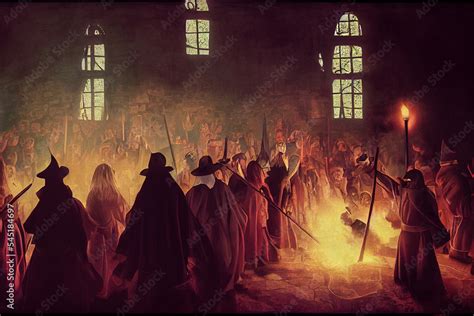burning witches at the stake|Witchcraft: Eight Myths and Misconceptions : Baguio The Salem witch trials were a series of hearings and prosecutions of people accused of witchcraft in colonial Massachusetts between February 1692 and May 1693. More than 200 people were accused. Thirty people were found guilty, nineteen of whom were executed by hanging (fourteen women and five men). One other man, Giles Corey, died under torture after refusing to enter a plea, an. In the menu above you can navigate between all the destinations where we have found and handpicked all the best rooms and suites with a private Jacuzzi® tub or spa tub.On our lists we offer photos and short descriptions of all our chosen accommodations, along with links to their sites on Booking.com, Hotels.com, Vrbo.com, and many more, so you can .

burning witches at the stake,In January 1692, a group of young girls in Salem Village, Massachusetts became consumed by disturbing “fits” accompanied by seizures, violent contortions and . In 1555 the Protestant bishops Hugh Latimer, Nicholas Ridley, and John Hooper were condemned as heretics and burned at the stake in Oxford, England. .
The 18th-century BCE law code promulgated by Babylonian King Hammurabi specifies several crimes in which death by burning was thought appropriate. Looters of houses on fire could be cast into the flames, and priestesses who abandoned cloisters and began frequenting inns and taverns could also be punished by being burnt alive. Furthermore, a man who began committing incest with .

The Salem witch trials were a series of hearings and prosecutions of people accused of witchcraft in colonial Massachusetts between February 1692 and May 1693. More than 200 people were accused. Thirty people were found guilty, nineteen of whom were executed by hanging (fourteen women and five men). One other man, Giles Corey, died under torture after refusing to enter a plea, an.
Witches were burned at the stake. Not in English-speaking countries. Witchcraft was a felony in both England and its American colonies, and therefore witches were hanged, .Witchcraft: Eight Myths and Misconceptions Myth: Convicted witches were burned at the stake in the U.S. “It was certainly true in parts of Europe,” says Baker. Joan of Arc is perhaps the most famous example of .
Britain has a long and bloody history of burning people accused of witchcraft at the stake. About 4,000 were sent to their death in Scotland and 1,000 in England, but .

Were any burned alive at the stake, a common punishment for convicted witches in Europe? After all, at the time Salem was part of the Province of . Were any burned alive at the stake, a common punishment for convicted witches in Europe? After all, at the time Salem was part of the Province of .
The infamous Salem witch trials began during the spring of 1692, after a group of young girls in Salem Village, Massachusetts, claimed to be possessed by the devil and accused several local.
Thousands of deaths at the stake. A leaflet in 1555 reports "a shocking scene" and shows the burning of alleged witches in Derenburg. It occurred during the peak of Europe's witch-hunting .The Witches' Well is a monument to accused witches burned at the stake in Edinburgh, Scotland, and is the only one of its kind in the city.. The memorial drinking fountain is attached to a wall at the lower end of the Castle Esplanade, below Edinburgh Castle, and located close to where many witches were burned at the stake. During the high point .The burning of Catherine Hayes. In England, burning was a legal punishment inflicted on women found guilty of high treason, petty treason, and heresy.Over a period of several centuries, female convicts were publicly burnt at the stake, sometimes alive, for a range of activities including coining and mariticide.. While men guilty of heresy were also burned .Claim: People accused of witchcraft were burned at the stake during the 1692 Salem witch trials in New England.burning witches at the stakeThe stench of their burning is with us yet. The stakes and gibbets where witches perished by the tens of thousands during early modern times still stand in popular imagination. For historians, the so-called great European witch-hunt has been a much-vexed issue, one easily contorted to suit the .burning witches at the stake Witchcraft: Eight Myths and Misconceptions The stench of their burning is with us yet. The stakes and gibbets where witches perished by the tens of thousands during early modern times still stand in popular imagination. For historians, the so-called great European witch-hunt has been a much-vexed issue, one easily contorted to suit the . Children dress up as witches without understanding the brutal history. A frenzy of witch-hunts took place during this time in Europe, mostly in German-speaking parts, with an estimated 60,000 people put to death. In mainland Europe and Scotland they burned them, with the peak period between 1580 and 1662 often referred to as The . During the eight years following the ordinance’s adoption, Denmark’s number of witchcraft trials increased, with accused individuals burned at the stake roughly every five days, per Agence .
Just as Maria was the first woman burned at the stake, the first women to be executed in New York and New Jersey were Black. The youngest girl put to death via the electric chair was Virginia .
burning witches at the stake|Witchcraft: Eight Myths and Misconceptions
PH0 · Witchcraft: Eight Myths and Misconceptions
PH1 · Witch hunts: Why were so few 'witches' killed in Wales?
PH2 · Were any 'witches' burned at Salem?
PH3 · Were Witches Really Burned at the Stake During the Salem
PH4 · Salem witch trials
PH5 · Salem Witch Trials: The Biggest Myths
PH6 · Salem Witch Trials
PH7 · List of people executed for witchcraft
PH8 · Death by burning
PH9 · Burning at the stake